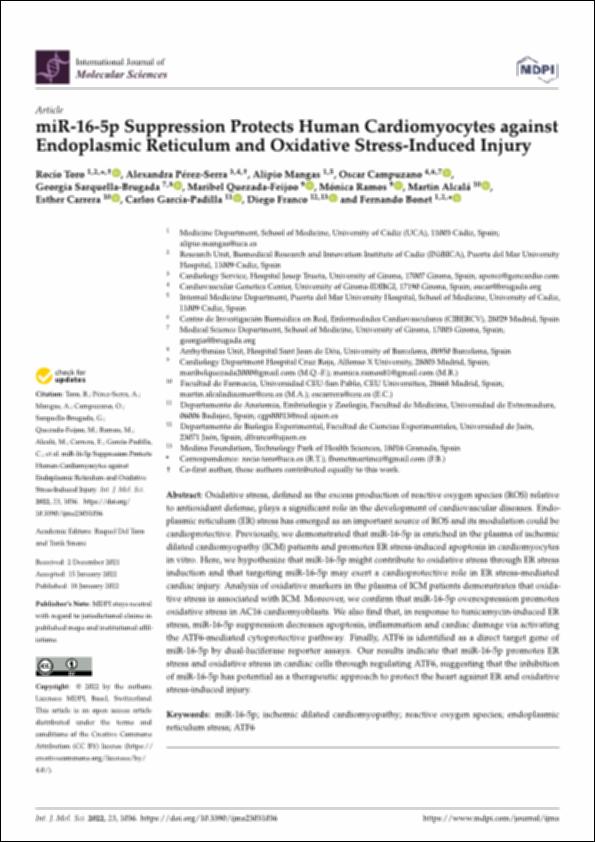Please use this identifier to cite or link to this item:
http://hdl.handle.net/10637/14697miR-16-5p Suppression Protects Human Cardiomyocytes against Endoplasmic Reticulum and Oxidative Stress-Induced Injury
| Title: | miR-16-5p Suppression Protects Human Cardiomyocytes against Endoplasmic Reticulum and Oxidative Stress-Induced Injury |
| Authors : | Toro Cebada, Rocío Perez-Serra, Alexandra Mangas Rojas, Alipio Campuzano, Oscar Sarquella-Brugada, Georgia Quezada‑Feijoo, Maribel Ramos, Mónica Alcalá Díaz-Mor, Martín Carrera Puerta, Esther García-Padilla, Carlos Franco, Diego Bonet Martínez, Fernando |
| Keywords: | miR-16-5p; Ischemic dilated cardiomyopathy; Reactive oxygen species; Endoplasmic reticulum stress; ATF6 |
| Publisher: | MDPI |
| Citation: | Toro, R.; Pérez-Serra, A.; Mangas, A.; Campuzano, O.; Sarquella-Brugada, G.; Quezada-Feijoo, M.; Ramos, M.; Alcalá, M.; Carrera, E.; García-Padilla, C.; et al.miR-16-5p Suppression Protects Human Cardiomyocytes against Endoplasmic Reticulumand Oxidative Stress-Induced Injury. Int. J. Mol. Sci. 2022, 23, 1036. https://doi.org/ 10.3390/ijms23031036 |
| Abstract: | Oxidative stress, defined as the excess production of reactive oxygen species (ROS) relative to antioxidant defense, plays a significant role in the development of cardiovascular diseases. Endoplasmic reticulum (ER) stress has emerged as an important source of ROS and its modulation could be cardioprotective. Previously, we demonstrated that miR-16-5p is enriched in the plasma of ischemic dilated cardiomyopathy (ICM) patients and promotes ER stress-induced apoptosis in cardiomyocytes in vitro. Here, we hypothesize that miR-16-5p might contribute to oxidative stress through ER stress induction and that targeting miR-16-5p may exert a cardioprotective role in ER stress-mediated cardiac injury. Analysis of oxidative markers in the plasma of ICM patients demonstrates that oxidative stress is associated with ICM. Moreover, we confirm that miR-16-5p overexpression promotes oxidative stress in AC16 cardiomyoblasts. We also find that, in response to tunicamycin-induced ER stress, miR-16-5p suppression decreases apoptosis, inflammation and cardiac damage via activating the ATF6-mediated cytoprotective pathway. Finally, ATF6 is identified as a direct target gene of miR-16-5p by dual-luciferase reporter assays. Our results indicate that miR-16-5p promotes ER stress and oxidative stress in cardiac cells through regulating ATF6, suggesting that the inhibition of miR-16-5p has potential as a therapeutic approach to protect the heart against ER and oxidative stress-induced injury. |
| URI: | http://hdl.handle.net/10637/14697 |
| Rights : | http://creativecommons.org/licenses/by-nc-nd/4.0/deed.es OpenAccess |
| ISSN: | 1422-0067 |
| Issue Date: | 18-Jan-2022 |
| Center : | Universidad San Pablo-CEU |
| Appears in Collections: | Facultad de Farmacia |
Items in DSpace are protected by copyright, with all rights reserved, unless otherwise indicated.


